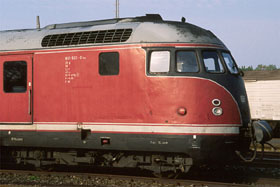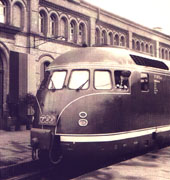VT 08.5
Introduction
Construction
In service
Introduction
In the fifties the express trains were mainly operated by locomotive hauled trains and SVT trainsets from before the war. So there was an urgent need to new and powerful trainsets. There were proposals for a new trainset. This new trainset was built with the experiences done with trainsets VT 92 501 "Kartoffelkäfer". This trainset was a trainset which was a by MAN rebuilt trainset VT 872 to test new driving concepts.
The DB entered a whole new area with the construction of the new trainset VT 08.5. The appearence of the trainsets suprised friend and enemy. The bullet shaped fronts of the trainsets were seen as progresive and dynamically. The trainsets consisted of a powercar, one middle coach and one steeringcar without power, but there could more middle coaches been added to the trainsets to extend it.
The first trainsets were deliverd in 1952. The powercars were indicated as DR4ü and designated as VT 08 501-514. The middle coaches were indicated as A4ü and got the numbers VM 08 501-515, and the steeringcars were indicated as A4ük and numbered as VS 08 501-513. At the end of May 1953 the fleet of VT 08.5 trainsets was complete. There were 13 trainsets available and one spare powercar and two middle coaches.
In 1954/55 a second delivery followed with six powercars and seven middle coaches. The middle coaches were unchanged in comparison with the first delivery and were numbered as VM 08 516-522. The second delivery of powercars VT was other than the first. The powercars had no dining compartment with kitchen anymore. This was because the powercars were often used as second powercar in four or five part trainsets. The powercars were indicated as A4ü with the numbers VT 08 515-520. The second series of powercars were 250 mm longer than the first series.
In total there are 20 powercars built, where 6 were without kitchen and dining. There are 22 middle coaches built and 13 steering cars.
The DB could by themself mix a trainset, depended on how many passengers they expected on the line. They had no fixed trainsets. For example there were trainsets with one steering car, two middle coaches and one powercar, but you could also seen trainsets with two powercars and three or four middle coaches.
Construction
 | | Photo: Kurt Bangert |
The coaches and powercars were of a selfcarrying construction. The body was welded on rafters. The skirtes, sidecarriers, bottoms, sidewalls and roofparts were constructed as selfcarrying elements, and got their strength by using sidecarriers. The fronts were, like the front of the test vehicle VT 92 501, from bended steal. In the powercars was, behind the cabin, a machine compartment with a sidecorridor. Behind the machine compartment was a luggage compartment situated. Then there was a store-room for the kitchen, an entrance compartment, a kitchen, a staff compartment and a dining compartment with 24 seats in an arrengment of 2+1. The middle coach had 10 closed compartments with a side corridor. In total the middle coach had 60 seats. On both sides of the coach was a toilet located. The compartments were 2060 mm long and 1900 mm wide and had each 6 upholstered seats. The steering coach had 8 compartments and one meeting compartment which was furnished with four movable seats and a table. In total one trainset with one middle coach and one steering coach had 112 seats first class.
A powered bogie existed of two double T sidesupporters. The driving wheels had a diameter of 930 mm and had sheet springs. The carrying wheels had a diameter of 900 mm and had coil springs. In the powered bogie was the engine, the hydraulic transmission and the light generator accomodated.
There are three different types of engines used in the VT 08.5, namely the Daimler Benz MB 820 Bb, the MAN L 12 V 17,5/21 B and the Maybach MD 650. The engines were hanging in a three points beared frame in the bogies. They made use of a cardan axle for the transmission from the diesel engine to the axles of a bogies. In total there were four different tranmission in use in the VT 08.5, namely the Maybach-Mekydro-Getriebe K 104 and K 104 SU, these were mechanical transmissions with four gears. The other transmissions were the transmission T 36 and LT 306r from Voith, these were hydro-dynamical transmissions with three gears.
The VT 08.5 was equiped with automatical air pressure brakes which were electrical operated. All axles had discbrakes which were operated with brake cylinders. Each bogie without power had an induction brake. The air pressure for the brakes was generated by means of an electrical driven generator. The 110 volt DC electrical network in the train was fed by this generator. When the train was not running a 300 Ah battery was used for the energy in the train. The steering coaches and middle coaches had each their own generators and batteries. The VT 08 515-520 were provided with an air heating installation.
All trainsets were equiped with Indusi and Sifa for security reasons. For services to France the trainsets were equiped with an electrical mechnical security system.
In service
The first new trainset which was delivered was the VT 08 501. On 22 April 1952 this trainset came to the Bw Frankfurt-Griesheim. The next four trainsets were delivered between 8 and 17 May 1952. From the winter timetable 1952/53 the trainsets went into service in the regular services. The trainsets were running in a scheme of four days a week. The following services were done with the trainsets VT 08.5: Ft 28/27 "Rheinblitz" Dortmund-München, Ft 46/45 "Schauinsland" Frankfurt-Basel and Ft 44/43 "Roland" Bremen-Basel. Until Oktober another three trainsets went into service, at that time the DB had 8 trainsets VT 08.5. These were in service together with the trainsets VT 07 501-502 on the same relations. At the end of May 1953 the fleet of VT 08.5 trainsets was complete. There were 13 trainsets and one spare powercar and two spare middle coaches.
With the winter timetable of 1953/54 three trainsets were moved to the Bw Hamburg-Altona, and with the summer timetable of 1954 another couple of trainsets were moved, but now to he Bw Dortmund Bbf. The first services of this new trainset already show that the new concept of the DB, modern and fast trainsets on the important domestic long-distance relations in Germany was a big succes.
 | | VT 08.5 in service as TEE train |
On 2 June 1957 the trainsets VT 08.5 had the honour to be the first TEE trains of the DB. They open the TEE-era at the DB. The logo of the international TEE trains was attached to the fronts of the trainsets just above the Scharfenberg couplers. The VT 08.5 was used in the TEE services until the trainsets VT 11.5 were ready. When these were delivered they took over the TEE trains from the VT 08.5. The trainsets VT 08.5 had only one month of service in the TEE trains because the first trainsets VT 11.5 were delivered at the end of June and went into service at the begin of July.
Due to the increasing electrification of mainlines and the delivery of new trainsets like the VT 11.5 it was more difficult to find new service areas for the VT 08.5. Because that, the DB decided to rebuilt the 10 year old trainsets to second class trainsets. The trainsets were renumbered to VT 12.6 and were going to ride in the same services as the trainsets VT 12.5. These services were mainly commuter trains.
On 6 May 1963 the first rebuilt trainset VT 12 609 left the AW Nürnberg with destination Braunschweig. From 1968 all rolling stock must renumbered in accordance with the new UIC guidelines, the trainsets VT 08.5 were renumbered to BR 608 and the trainsets VT 12.6 were renumbered to BR 613. Besides Bw Köln Nippes, which accomodated for a short time three trainsets BR 613, most of the rebuilt "Eierköpfen" were moved to Bw Hamburg-Altona and Bw Braunschweig 1. Many years the trainsets stayed in Braunschweig. All the time they had their service on the same line. But when the line Braunschweig-Hannover was electrified in 1976 the service of the trainsets was changed. With the summer timetable of 1982 all trainsets 612 and 613 were moved from Hamburg to Braunschweig. At the end of May 1985 the trainsets 613 were taken out of service. The last run was on 6 May 1985 when a trainsets 613 stood in for a trainset 634.
| Type nr: |
VT 08.5 |
| In service: |
1952 |
| Manufacturer: |
MAN |
| Axle layout: |
B'2'+2'2'+'2'2' |
| Gauge: |
1435 mm |
| Length: |
79,970 m |
| Weight: |
120 t |
| Traction: |
Diesel hydraulisch/mechanisch
Dieselmotor:
Aantal: 2
Fabrikant: Maybach, Daimler, MAN
Vermogen: 736 kW
(bij 1500 tpm) |
| Speed: |
120/140 km/h |
| Number of seats: |
114 (1ste klas)
na ombouw naar VT 12.6 (613)
30 (1ste klas) en 138 (2de klas) |
|
